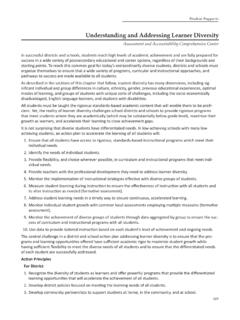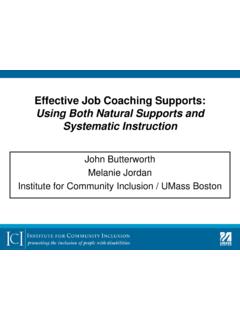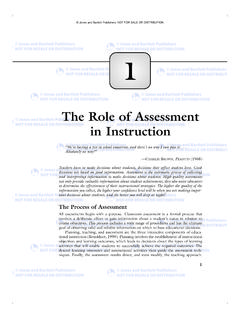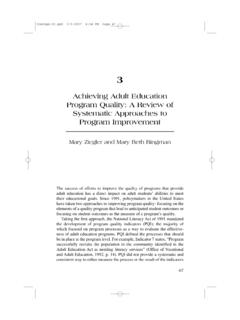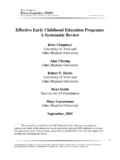Transcription of Five Meanings of Direct Instruction - centerii.org
1 Center onInnova tion & ImprovementTwin paths to better schoolsFive Meanings of Direct InstructionBarak RosenshineThe opinions expressed herein do not necessarily reflect the position of the supporting agencies, and no official endorsement should be inferred. 2008 Academic Development InstituteCenter on Innovation & Improvement121 N. Kickapoo StreetLincoln, IL 62656 USAP hone: 217-732-6462 Fax: Tools TrainingPositive results for students will come from changes in the knowledge, skill, and behav-ior of their teachers and parents. State policies and programs must provide the opportu-nity, support, incentive, and expectation for adults close to the lives of children to make wise Center on Innovation & Improvement helps Regional Comprehensive Centers in their work with states to provide districts, schools, and families with the opportunity, information, and skills to make wise decisions on behalf of national content center supported by the U. S. Department of Education s Office of Elementary and Secondary #S283B050057 Series Editor: Herbert J.
2 WalbergCopy Editors: Lori Thomas, Pam SheleyDesign: Pam SheleyExecutive Director: Sam Redding1 Synthesis Series: RosenshineIntroductionDirect Instruction refers to Instruction led by the teacher, as in the teacher provided Direct Instruction in solving these problems. But if one enters Direct Instruction into an ERIC (Educational Resources Information Center) search, one finds that the term has appeared with a variety of Meanings , some general and some specific, some posi-tive and some negative. This problem occurs because Direct Instruction , and terms such as Direct teaching and explicit Instruction , has both a general meaning and a specific meaning. The general meaning refers to any Instruction that is led by the teacher regardless of quality. However, as will be discussed, the term Direct Instruction also has three specific uses: (a) the instructional procedures that were used by the most effective teachers, (b) the procedures that were used in ex-perimental studies where students were taught cognitive strategies to use in reading or writing, or (c) the instruc-tional procedures that are used in Distar different Meanings create a problem for the reader when authors do not specify the specific Meanings they are using.
3 And often, even authors are not aware that the term Direct Instruction has these different Meanings . The purpose of this article is to describe these different instructional Meanings and specify the differences among them. But even these descriptions may not be sufficient to decipher articles when authors use the term Direct instruc-tion without specifying to what they are referring. I suggest that there are five overlapping uses of the term Direct Instruction : 1. Academic Instruction that is led by a teacher re-gardless of the quality of The instructional procedures that were used by effective teachers in the teacher effects Instructional procedures used by teachers when they taught cognitive strategies to Instructional procedures used in the Distar (Di-rect Instruction Systems in Arithmetic and Read-ing) programs. 5. Instruction where Direct Instruction is portrayed in negative terms such as settings where the teacher lectures and the students sit PrinciplesThe General Teacher-Led MeaningThe term Direct Instruction has been used for over a century to refer to any academic Instruction that is led by the teacher.
4 This term appeared in 1893 in Joseph Meyer Rice s book, The Public School System of the United States. Rice complained in many of the grades the chil-dren received Direct Instruction for no more than two or two and a half of the five hours spent in school, the pupils being engaged in busy-work more than half the time (pp. 153-154). Similarly, a description of a reading program noted that A child spends part of each hour receiving Direct instruc-tion from a teacher in skills development and spends the remainder of the hour in reinforcement activities under the supervision of an aide (Broward County Schools, 1974). Currently, many state departments of education and school districts refer to Direct Instruction or synonyms such as Direct teaching or explicit Instruction . Unfortu-nately, these reports seldom specify the specific instruc-tional procedures associated with the term. Reading these documents, we do not know whether Direct Instruction is being used to refer to any Instruction by the teacher or to a set of specific instructional procedures.
5 We are seldom told how Direct Instruction differs from discovery learning. We assume that in Direct Instruction a teacher models and demonstrates a skill, but when Direct Instruction is used in this general sense, we are seldom given any instructional specifics, and it is left to the reader to infer what the term Teacher Effects Pattern Direct Instruction also refers to a specific pattern of Instruction that emerged from studies which attempted to identify the instructional procedures used by the most effective teachers, those teachers whose students made the greatest gains in achievement. This research is also referred to as the teacher effectiveness, teacher effects, or process-product research. Research in this process-product tradition begins with first locating 20 to 30 teachers all of whom are teaching the same grade. All the classrooms are then administered pretests in reading or mathematics or the subject of inter-est. Next, observers visit the teachers classrooms and observe and record the frequency of different instructional behaviors.
6 Such behaviors include the number and type of questions that are asked, the frequency of feedback provided by the teacher, the amount of time spent in presentation and in guided practice, and how the teacher prepares students for independent practice. At the end of these observations, all the students take a posttest, and the pretest and posttest scores are statistical-ly analyzed to determine which teacher s classrooms made the largest and smallest gains, after adjusting for differ-ences in the initial abilities of the students. In effect, we now have two sets of teachers: those whose students made the largest and smallest academic gains during the time of study. We are now able to list and compare the instruc-tional behaviors of those teachers whose classes made the largest gains with the instructional behaviors of those teachers whose classes made the smallest gains. Thus, in this final step, the two groups of teachers are compared 2 Synthesis Series: Rosenshineon the recorded behaviors such as frequency of questions, types of questions, and types of feedback to students.
7 These correlational studies were followed by experimental studies where one group of teachers received instruc-tion in the most effective instructional procedures and a control group of teachers continued their regular teach-ing. Students taught by the teachers who received these experimental instructions made significantly greater gains in mathematics (Good & Grouws, 1979) and in reading (Anderson, Evertson, & Brophy, 1979). My purpose in giving the above detail is to demonstrate that all of the instructional procedures in this effective teacher pattern are empirically based and came from the study of those teachers whose classes gained the most on standardized tests. McDonald and Elias (1976) and Rosenshine and Stevens (1986) believed that the results in these studies fit a specif-ic pattern, and they called this pattern Direct Instruction . Rosenshine and Stevens concluded that across a number of studies, when effective teachers taught well-structured topics ( , arithmetic computation, map skills), the teachers used the following pattern: Begin a lesson with a short review of previous a lesson with a short statement of goals.
8 Present new material in small steps, providing for student practice after each step. Give clear and detailed instructions and explanations. Provide a high level of active practice for all students. Ask a large number of questions, check for student understanding, and obtain responses from all students. Guide students during initial practice. Provide systematic feedback and corrections. Provide explicit Instruction and practice for seatwork exercises and monitor students during seatwork. Rosenshine and Stevens further grouped these instruc-tional procedures under six teaching functions, as shown in Table 1. Hunter s (1982) work, particularly her six step lesson plan, fits the teacher effectiveness model. Indeed, the term guided practice was one of Hunter s important contributions. Table 1: Results from the Effective Teacher ResearchReduce the difficulty of the task during initial lesson the task into smaller 1: Results from the Effective Teacher ResearchUse scaffolds and guidance to support students during initial models use of the strategy or thinks aloud as strategies are selected and choices are student for student responses from all combine the components into a supportive systematic correc-tions and check models of the completed students with fix-up for extensive stu-dent independent (1982) suggests we use the term supported Instruction because the distinction between the more effective and the less effective teachers lies in the amount of instructional support that they provide for their stu-dents.
9 Others have suggested that we use the term Direct teaching. Specific instructional programs. There are a number of instructional programs that use forms of systematic and Direct Instruction and which have been successful with students from low-income families. Three such programs in reading are Open Court Reading, ECRI Reading, and Cooperative Integrated Reading and Comprehension (CIRC). The American Federation of Teachers (1998) has provided a description of each of these programs as well as the relevant supporting research. Two successful Direct Instruction programs in mathemat-ics are Saxon Math (Saxon Publishers, 2005) and Team Accelerated Instruction : Math (Promising Practices Net-work). The websites in the references provide documenta-tion of the success of these American Institute of Research (2005) assembled the research on school-wide programs in reading and math-ematics and rated the Success for All school-wide program as moderately strong in overall positive effects and rated the Core Knowledge program as moderate in overall positive effects.
10 The instructional procedures in both pro-grams employ systematic and Direct one - when created, is to be inserted here3 Synthesis Series: RosenshineThe Cognitive Strategies Meaning Beginning around 1968, researchers used Direct instruc-tion as a summary term for the instructional procedures used to teach higher level cognitive tasks. For example, in summarizing the results of the 27 projects involving 20,000 students in the First-Grade Reading Studies (Dyk-stra, 1968), one of the coordinators of the project wrote that Direct Instruction in comprehension is essential. Since that time, the term Direct Instruction has been used in a number of studies where strategies for reading comprehension were taught (Berkowitz, 1986; Lonberger, 1988; Palincsar & Brown, 1983, 1989). Dermody (1988) referred to her work as Direct Instruction of the specific comprehension strategies of predicting, clarifying, ques-tion-generating, and summarizing .. (p. 57), and Grajia (1988) referred to her work as Direct Instruction of a summarization strategy (p.)

